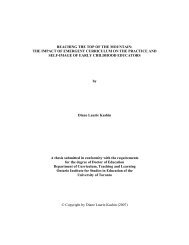The Reading Chair
You also want an ePaper? Increase the reach of your titles
YUMPU automatically turns print PDFs into web optimized ePapers that Google loves.
a natural way to make movement fun and empowering and to give children<br />
greater body awareness. <strong>The</strong>se are how-to books for the younger set.<br />
Little Yoga: A Toddler’s First Book of Yoga<br />
Written by Rebecca Whitford. Illustrated by Martina Selway.<br />
Don’t expect to read this book straight through; the children in your<br />
classrooms will want to interrupt to try the poses on each page. This<br />
age-appropriate introduction to yoga, which steers clear of technicalities,<br />
teaches children to imitate familiar animals: “Yoga baby breathes like a<br />
lion—haaaaa” and “crouches like a frog.” <strong>The</strong> yoga practice offered here is<br />
immediately appealing and accessible to young ones. A few pages of photographs<br />
and explanation at the back of the book complement the colorful<br />
illustrations throughout.<br />
After reading this book to children, teachers can<br />
• Invite a yoga instructor to visit the class to teach the children some simple<br />
poses.<br />
• Plan other activities that invite children to move their bodies in different<br />
ways—jumping rope, dancing with hula hoops, and line dancing, for<br />
example.<br />
More books about movement<br />
From Head to Toe, by Eric Carle.<br />
Get Up and Go, by Nancy Carlson.<br />
Move, by Steve Jenkins and Robin Page.<br />
We’re Going on a Bear Hunt, by Michael Rosen; illus. by Helen Oxenbury.<br />
Books<br />
Writing<br />
Writing is a powerful way to express oneself. By putting thoughts to<br />
paper, you can tell a story, write the U.S. president a letter, or request a<br />
book at the library. Learning to write begins well before children put full<br />
sentences to paper. It begins as children<br />
gain familiarity with the alphabet, learn<br />
about writing instruments—pencils,<br />
crayons, and computer keyboards—and<br />
recognize simple words in everyday<br />
places, such as STOP on the familiar red<br />
street sign. Environmental print, such as<br />
that featured in City Signs, offers contextual<br />
hints that make deciphering words<br />
even more fun. With the variety of wonderful<br />
books on the subject, early literacy<br />
learning should be anything but rote.<br />
Good alphabet books are visually stunning<br />
(Alphabet Under Construction) and<br />
can include a solid story line (Max’s ABC).<br />
Learning to write begins<br />
as children gain familiarity<br />
with the alphabet,<br />
learn about writing<br />
instruments, and recognize<br />
simple words in<br />
everyday places, such<br />
as STOP on the familiar<br />
red street sign.<br />
Beyond the Journal • Young Children on the Web • May 2007


















